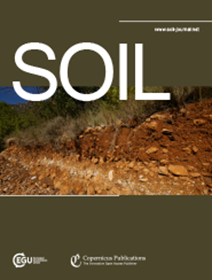不同草地类型土壤微生物坏死体碳对土壤有机碳组分的贡献及其影响因素
IF 4.3
2区 农林科学
Q1 SOIL SCIENCE
引用次数: 0
摘要
摘要。微生物坏死物碳(MNC)是土壤有机碳(SOC)的重要来源,但不同草地类型微生物坏死物碳对土壤有机碳组分的定量贡献及其调控机制尚不清楚。本研究通过对宁夏草甸草原(MS)、典型草原(TS)、荒漠草原(DS)和草原荒漠(SD) 4种草地类型(0-20 cm、20-40 cm和40-100 cm)土壤剖面的综合调查。定量分析了矿物伴生有机碳(MAOC)、颗粒有机碳(POC)及其微生物坏死物碳(TNC)、真菌坏死物碳(FNC)和细菌坏死物碳(BNC),并分析了它们对土壤有机碳组分的贡献及其影响因素。我们的发现揭示了三个关键的见解。(1) 0 ~ 100 cm土层中MAOC和POC含量的大小顺序为:草甸草原(MS) >;典型草原(TS) >;荒漠草原(DS);草原荒漠(SD), POC的平均含量为9.3 g/kg,高于MAOC的平均含量(8.73 g/kg)。(2)微生物TNC在MAOC和POC中的含量随土层深度的增加而降低,FNC的平均含量为3.02 g/kg和3.85 g/kg,高于BNC的平均含量(1.64 g/kg和2.08 g/kg)。FNC在MAOC和POC中均占主导地位,其贡献高于BNC。第三,通过回归分析和随机森林模型,我们确定了跨国公司动态的关键环境驱动因素:年平均降雨量(MAP)、电导率(EC)和土壤总氮(TN)是表层土壤(0-20cm)的主要调节因素,而速效钾(AK)、有机碳(SOC)和年平均温度(MAT)在深层土壤(20-100 cm)中占主导地位。本研究主要通过:1)建立土壤剖面中有机质和有机碳组分的垂直分布格局;2)量化不同草地生态系统土壤剖面中土壤有机碳组分的相对贡献并阐明其环境控制作用,为深入了解不同草地生态系统土壤有机碳组分积累的驱动机制提供依据,为进一步研究干旱半干旱区土壤有机碳形成和积累的微生物机制提供数据支持。本文章由计算机程序翻译,如有差异,请以英文原文为准。
Contribution of soil Microbial Necromass Carbon to Soil Organic Carbon fractions and its influencing factors in different grassland types
Abstract. Microbial necromass carbon(MNC) is a significant source of soil organic carbon (SOC), the quantitative contribution of MNC to distinct SOC fractions and its regulatory mechanisms across various grassland types remain largely unexplored. This study through a comprehensive investigation of soil profiles (0–20 cm, 20–40 cm, and 40–100 cm) across four grassland types in Ningxia, China, encompassing meadow steppe (MS), typical steppe (TS), desert steppe (DS), and steppe desert (SD). We quantified mineral-associated organic carbon (MAOC), particulate organic carbon (POC), and their respective microbial necromass components, including total microbial necromass carbon (TNC), fungal necromass carbon (FNC), and bacterial necromass carbon (BNC), and analyzed the contributions to SOC fractions and influencing factors. Our findings reveal three key insights. First, the contents of MAOC and POC in the 0–100 cm soil layer were in the following order of magnitude: Meadow steppe (MS) >Typical steppe (TS) > Desert steppe (DS) > Steppe desert (SD), with the average content of POC was 9.3 g/kg, which was higher than the average content of MAOC (8.73 g/kg). Second, the content of microbial TNC in MAOC and POC decreased with the depth of the soil layer, the average content of FNC was 3.02 g/kg and 3.85 g/kg, which was higher than the average content of BNC (1.64 g/kg and 2.08 g/kg). FNC dominated both MAOC and POC, and its contribution was higher than the contribution of BNC. Thid, through regression analysis and random forest modeling, we identified key environmental drivers of MNC dynamics: mean annual rainfall (MAP), electrical conductance (EC), and soil total nitrogen(TN) emerged as primary regulators in surface soils (0–20cm), while available potassium(AK), SOC, and mean annual temperature (MAT) dominated deeper soil layers (20–100 cm). This research by: 1) establishing the vertical distribution patterns of MNC and SOC fractions in soil profiles; 2) quantifying the relative contributions of MNC to SOC fractions across different grassland ecosystems soil profiles and elucidating their environmental controls, offering a deeper understanding of the mechanisms driving MNC to soc fractions accumulation in diverse grassland ecosystems, and provide data support for further research on the microbiological mechanisms of soil organic carbon formation and accumulation in arid and semi-arid regions.
求助全文
通过发布文献求助,成功后即可免费获取论文全文。
去求助
来源期刊

Soil
Agricultural and Biological Sciences-Soil Science
CiteScore
10.80
自引率
2.90%
发文量
44
审稿时长
30 weeks
期刊介绍:
SOIL is an international scientific journal dedicated to the publication and discussion of high-quality research in the field of soil system sciences.
SOIL is at the interface between the atmosphere, lithosphere, hydrosphere, and biosphere. SOIL publishes scientific research that contributes to understanding the soil system and its interaction with humans and the entire Earth system. The scope of the journal includes all topics that fall within the study of soil science as a discipline, with an emphasis on studies that integrate soil science with other sciences (hydrology, agronomy, socio-economics, health sciences, atmospheric sciences, etc.).
 求助内容:
求助内容: 应助结果提醒方式:
应助结果提醒方式:


